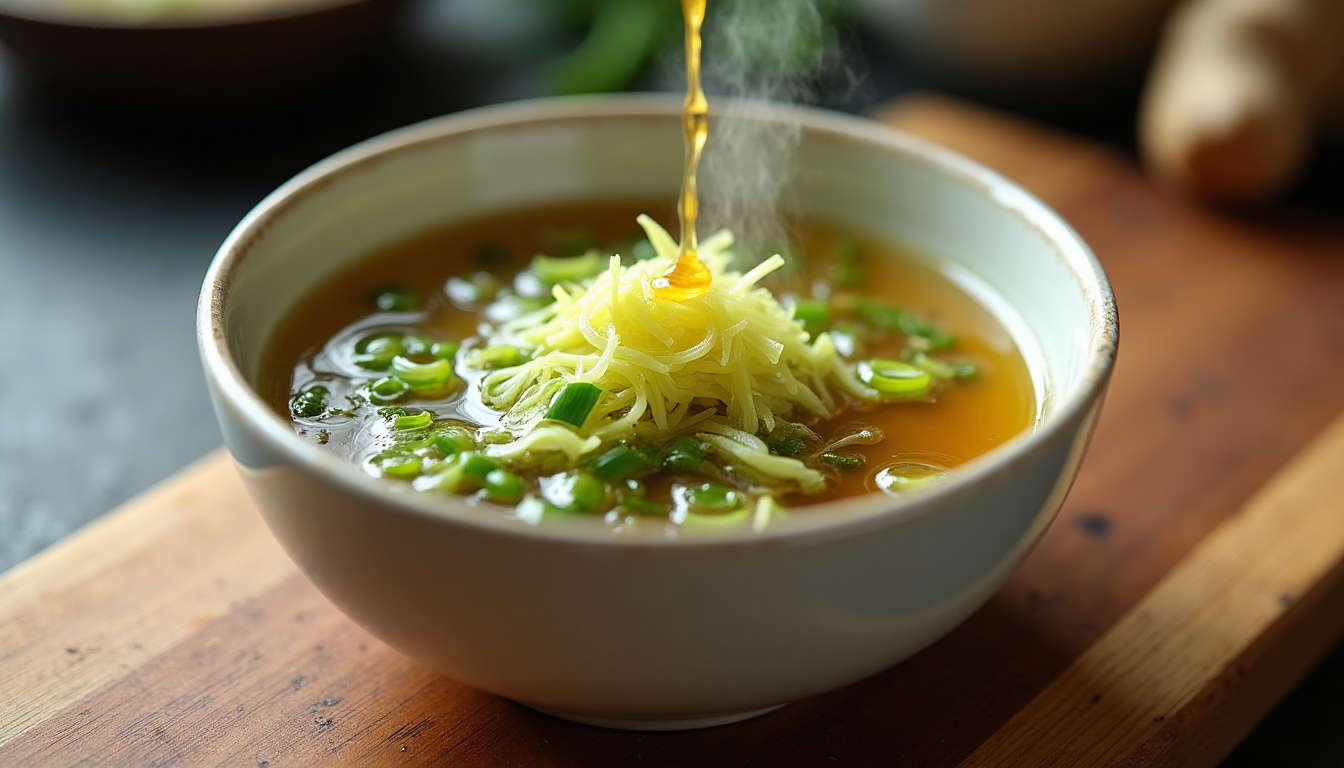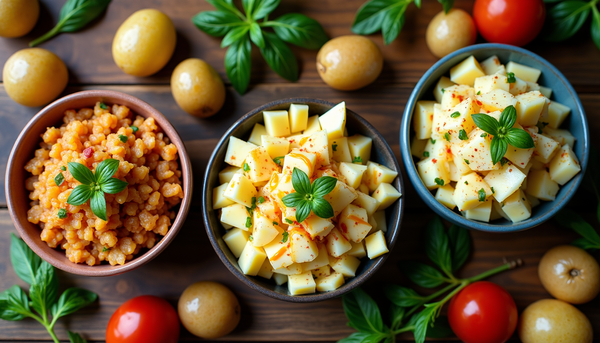Why Ginger Scallion Sauce Will Change How You Cook Forever

Why Ginger Scallion Sauce Will Change How You Cook Forever
I'm gonna be honest with you – I used to be that person who hoarded those little packets of ginger scallion sauce from Hainanese chicken rice places. Like, embarrassingly so. My fridge door was basically a graveyard of takeout condiments because I couldn't bear to throw away something so perfect.
Then my grandmother caught me doing this during one of her visits and just... stared at me. You know that look Asian grandmothers give you when you're being ridiculous? Yeah, that one.
"Maya," she said in her mix of Cantonese and heavily accented English, "you know this takes five minutes to make, right?"
And that's how I learned that one of the most transformative sauces in Chinese cuisine – something that can make literally anything taste better – was sitting right there in my pantry ingredients the whole time.
The Sauce That Built a Cuisine
Ginger scallion sauce isn't just another condiment. In Cantonese cooking, it's basically liquid gold. My grandmother's generation used it on everything from plain white-cut chicken to steamed fish, and honestly? They were onto something that goes way beyond traditional applications.
The genius lies in its simplicity. Five ingredients: scallions, fresh ginger, garlic, soy sauce, and neutral oil. That's it. But when you combine them with the right technique – and here's where most people mess up – you get this sauce that hits every single taste receptor in your mouth.
Sweet from the scallions. Pungent heat from the ginger. Umami depth from the soy sauce. And that sizzling hot oil? It's not just for drama (though the drama is fun). It actually blooms the aromatics and creates these complex flavor compounds that you simply can't get any other way.
The Science of Sizzle
Let me geek out for a second because this is where cooking gets really interesting. When you pour that hot oil over the aromatics, you're essentially flash-frying them. The high heat releases sulfur compounds from the scallions and gingerols from the ginger – these are the same compounds that make your kitchen smell absolutely incredible when you're stir-frying.
But here's what most recipe blogs won't tell you: the temperature matters. Too hot, and you'll burn the delicate scallion greens. Too cool, and you won't get that proper sizzle that extracts all those flavors. You want the oil hot enough that a single scallion piece dropped in immediately bubbles vigorously – think angry hot tub, not violent volcano.
I learned this the hard way after ruining approximately seven batches in a row. My kitchen smelled like burnt onions for a week, and I was convinced I'd never master it. Turns out, I was just being impatient with heating the oil and way too aggressive with the temperature.
Let's Talk About That Salmon Recipe
Now, about this honey salmon situation – can we just acknowledge how brilliant this pairing is? Whoever first decided to drizzle ginger scallion sauce on honey-glazed salmon deserves some kind of culinary medal.
The honey creates this beautiful caramelized crust on the salmon (thanks, Maillard reaction), while the ginger scallion sauce cuts through all that richness with bright, sharp notes. It's like... imagine if someone took the best parts of teriyaki and elevated it with actual technique instead of just dumping bottled sauce on everything.
Here's my honest take on making this dish: yes, it's technically a 30-minute meal, but don't rush the sauce. I know, I know – we're all busy, and the promise of quick dinner is appealing. But taking an extra five minutes to get that oil temperature right will make the difference between a good meal and something that makes you go "OH" on the first bite.
The Method (With My Personal Disasters Included)
For the salmon part: This is pretty straightforward, but I have thoughts. First, please don't skip the initial brush of soy sauce and honey on the raw fish. I used to think this was unnecessary because we're adding sauce later anyway, but it creates this gorgeous lacquered finish that plain roasted salmon just can't match.
Also, about those green beans – French green beans (haricots verts) really are worth seeking out if you can find them. Regular green beans work fine, but the thinner ones cook at exactly the same rate as the salmon, which means you get perfectly done vegetables without any of that "crisp salmon, mushy vegetables" situation.
For the sauce: Get yourself a heatproof bowl. I cannot stress this enough. I once used a regular ceramic bowl thinking "how hot could it be?" and ended up with sauce all over my stovetop and a bowl in two pieces. Learn from my mistakes, people.
Heat that oil until you see tiny bubbles forming around the edges – not rolling bubbles, just little ones. While it's heating, prep everything else. Slice your scallions (I separate the white and green parts because they cook differently), grate or mince your ginger super fine, same with the garlic.
When the oil is ready, pour it over the white parts of the scallions and the ginger-garlic mixture first. Listen for that satisfying sizzle. Then add your soy sauce and the green parts of the scallions. The order matters because those delicate green tops will turn bitter if they get too much direct heat.
Where This Gets Really Exciting
Here's where I'm gonna push you out of your comfort zone a little: don't stop at salmon. This sauce is basically a cheat code for making anything taste restaurant-quality.
I've tried it on:
- Grilled chicken thighs (incredible)
- Pan-seared tofu (even my carnivore friends were impressed)
- Roasted vegetables (especially eggplant and broccoli)
- Scrambled eggs (weird but surprisingly good)
- Even pasta (I know, I know, but trust me on this one)
The key is understanding that ginger scallion sauce isn't trying to be the star of the show – it's like that friend who makes everyone else funnier just by being there.
Common Mistakes (That I've Made So You Don't Have To)
Mistake #1: Using old ginger. Fresh ginger should be firm and have that almost spicy smell when you break the skin. If it's wrinkled or soft, just... don't. The sauce will taste flat and you'll wonder why everyone raves about this.
Mistake #2: Cutting corners on the scallions. I used to think any onion-y thing would work, so I tried it with regular onions, chives, even leeks. Nope. Scallions have this specific sweetness and texture that's irreplaceable.
Mistake #3: Making it too far ahead. This sauce is best used within a few hours of making it. It doesn't go bad exactly, but it loses that bright, vibrant quality that makes it special. Plan to make it while your salmon is roasting.
Mistake #4: Being afraid of the sizzle. I know pouring hot oil can be intimidating, but that dramatic bubbling is exactly what you want. Pour steadily but deliberately – not all at once, but don't be tentative about it either.
The Bigger Picture
What I love most about this recipe is how it represents everything good about fusion cooking. It takes a traditional Cantonese technique and applies it to ingredients and methods that work for how we actually cook today. Sheet pan dinners, 30-minute meals, weeknight cooking – but without sacrificing the depth of flavor that makes food memorable.
Too often, "quick" recipes mean "dump everything in a pan and hope for the best." This approach respects both your time constraints and your taste buds. Yeah, you're using frozen brown rice from Trader Joe's (no judgment – I do it too), but you're also taking the time to properly bloom aromatics and build real flavor.
My grandmother would probably have opinions about the honey (she's pretty traditional), but I think she'd appreciate the technique. And honestly? That's what good cooking is about – understanding the principles well enough to adapt them to your own kitchen, your own ingredients, your own life.
Your Turn to Experiment
So here's my challenge to you: make this salmon recipe exactly as written the first time. Don't substitute, don't "improve" it, just follow it. Then, once you get comfortable with the ginger scallion sauce technique, start playing around.
Try it with different proteins. Experiment with adding sesame oil or chili flakes. See what happens when you use it as a marinade instead of just a finishing sauce. Cook with it until you understand not just how to make it, but why it works.
And please, for the love of all that's holy, make extra sauce. You'll want to put it on everything for the next three days, and trust me – you'll thank yourself for batch-cooking this magic.
Drop a comment and let me know how your first attempt goes. Did you get that perfect sizzle? Did you burn anything? (It's okay if you did – we've all been there.) Most importantly, did it make you rethink what you thought you knew about weeknight cooking?
Because that's really what this is about. Not just making dinner faster, but making it better. And sometimes, the best improvements come from techniques that have been around for generations, just waiting for us to pay attention.




